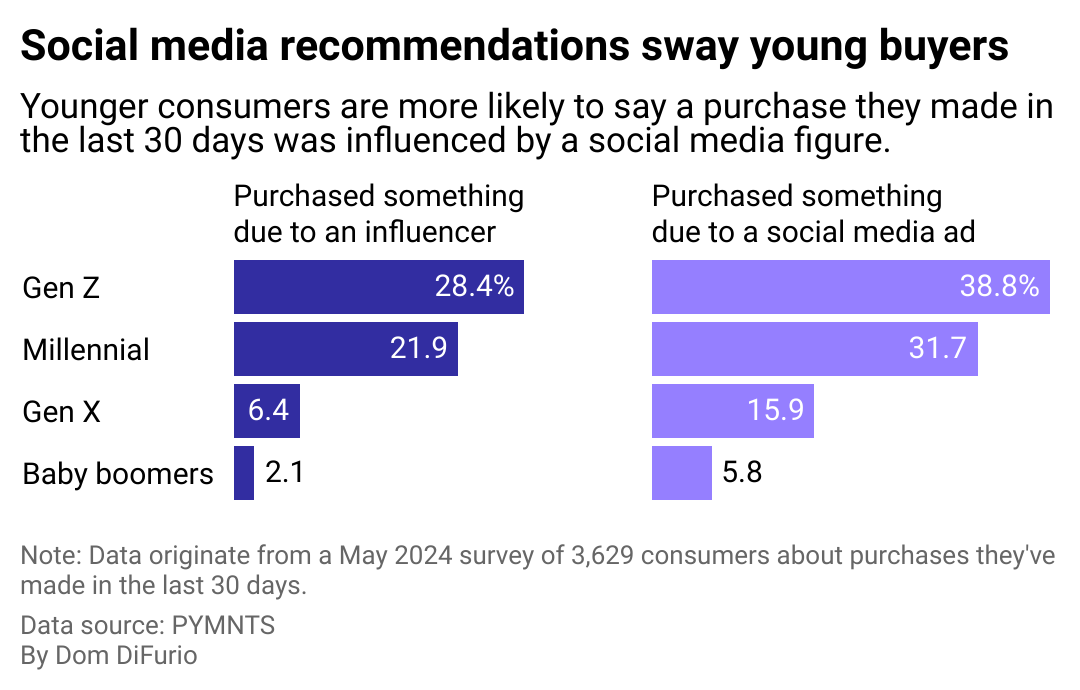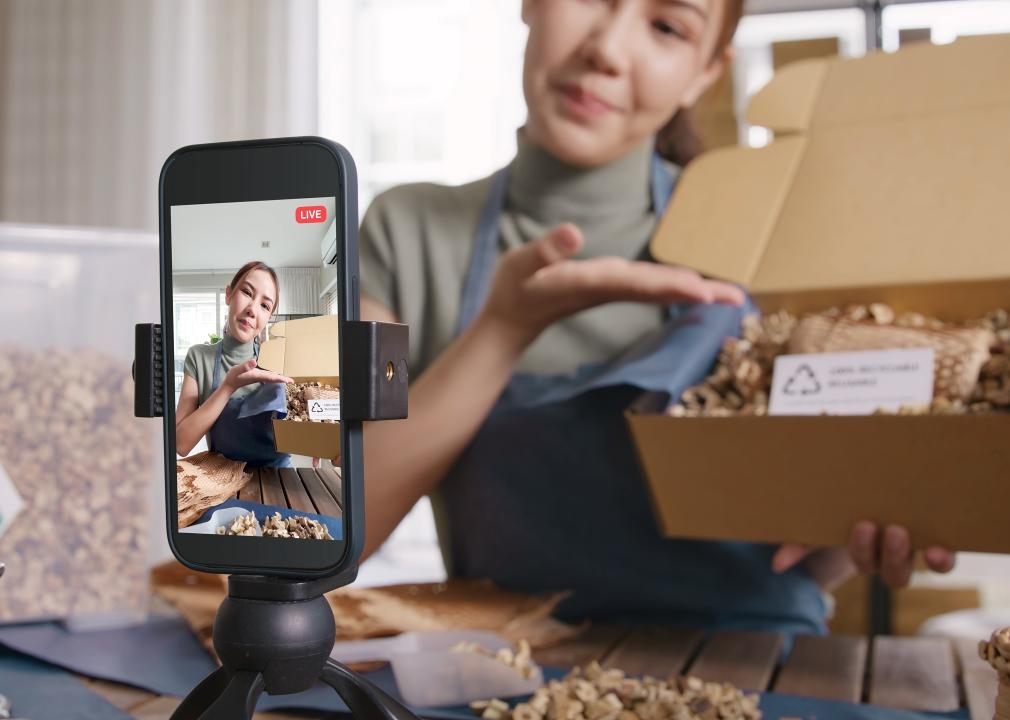The Gen Z QVC: How social media influences generational shopping habits
Chay_Tee // Shutterstock
The Gen Z QVC: How social media influences generational shopping habits
A social media influencer with her phone set up to record shows a package on a live video.
If you think you don’t need a Lululemon belt bag, Scrub Daddy sponges, or a Revlon one-step hair dryer, your social media feed might convince you otherwise. These are but two sold-out items that went viral thanks to #TikTokMadeMeBuyIt. The hashtag has had more than 129 billion views since launching.
Social media has transformed into social commerce, a trend born long before TikTok, owned by the Chinese company ByteDance, launched its shop feature last year. In the U.S., e-commerce sales accounted for over 15% of all sales in the second quarter of 2024, and the value of sales grew 9% from the same period the year before, according to Census data.
But TikTok’s frictionless shopping experience, which features live streams and videos that allow—and even encourage—viewers to make purchases directly in the app via the “shop” button, has been a game changer. The rise of e-commerce that pushes consumers to make decisions based on social media ads and promotional videos has profoundly affected Gen Z’s shopping habits, according to a 2024 survey from social media forecaster eMarketer. Just over 2 in 3 Gen Zers say they’re likely to make an in-app purchase on TikTok, compared to less than 1 in 5 social media users from all other generations.
In theory, its creators designed social media platforms for interpersonal connection, not commerce. But, like Facebook Marketplace, apps like TikTok and Instagram are doubling down on their role as merchants. Thanks to the shop feature, TikTok offers millions of users the chance to purchase a wide array of things, such as household goods or $10 “Taylor Swift for President” flags—but it may be destroying what users love about the app in the process.
One way TikTok has turned the app into a virtual mall is by integrating the TikTok Shop in the main feed so that product videos pop up while users browse. The feature has transformed the curated content on the app’s “For You Page” into “a scrolling infomercial,” and some media critics see it as a far cry from the app’s initial mission of discretion and credibility in favor of flagrant selling. It’s also a win for TikTok, which takes a commission from third-party sellers.
But how, exactly, does that influence shopping? Collabstr analyzed surveys from PYMNTS, eMarketer and others to illustrate the ways social media is influencing the shopping habits of young consumers.
![]()

Collabstr
When scrolling turns into shopping
A stacked bar chart showing what percentage of consumer from each generation say they’ve made a purchase in the last 30 days influenced by a social media influencer. Gen Z leads with 28% saying they’ve made an influencer influenced purchase, followed by 22% of Millennials, 6% of Gen X, and 2% of Baby Boomers.
To online-centric shoppers, calling the 1-800 number on the screen to purchase whatever gadget or beauty product is being highlighted on air might seem decidedly old school. However, the approach perfected by network shopping channels like QVC and HSN, which provide an in-home shopping experience built on relationships, exclusive discounts, big names, and even bigger personalities, has plenty of commonality with Canvas Beauty. The cosmetics brand made a record-setting $1 million in sales after a six-hour live stream on TikTok Shop, showing that if you can capture someone’s attention, you might be able to capture their money, too.
There are surprising similarities and stark differences in how different generations spend their dollars, especially in an era where every social media platform is now a virtual shopping center. This total integration begs the question: Are these new platforms different than older models for Gen X and baby boomers, or is it just a case of a new medium spouting out the same message: to sell, sell, sell?
The younger generation’s reliance on influencers has created a slew of new marketing strategies. By keeping purchasing in-house, it results in big business for apps that take commission from third-party sellers. The potential for profits is so significant that TikTok was willing to lose money in 2023 as it launched in the U.S. and has raised seller fees.
In some sense, TikTok Shop still has an untapped audience. While older generations are less inclined to make purchases directly from social media, they’re more established and have plenty of purchasing power.
The data also reveals salient generational differences concerning a brand’s relationship to sustainability and social justice. Hubspot’s 2024 Consumer Trends Report found that younger consumers are more invested in ethical shopping. They value more sustainable products that are better for the environment and prefer to shop at companies that take a stance on social issues, specifically racial justice, LGBTQ+ rights, gender inequality, and climate change. Conversely, the majority of baby boomers say that companies should not take a strong stance on social issues.
While Gen Z and millennial shoppers are more interested in virtual marketing and online shopping than baby boomers, who still allow TV ads and retail stores to dictate what they buy, boomers tend to spend more per purchase, according to a 2024 Whop survey.
The popularity of TikTok Shop represents something new that will inevitably impact all generations: the full integration of shopping and entertainment. But despite the platform’s continued growth, the pendulum may swing back if commerce ever fully eclipses engagement.
Take, for instance, the rise and fall of Instagram Live Shopping, which began in 2020 and had relative success. However, its sales and engagement quickly plummeted, and Instagram discontinued the feature in 2023. By deprioritizing retail, Instagram could refocus on the app’s mission to “bring people together” around concepts of connection and creativity, Instagram’s CEO Adam Mosseri explained in a video post, rather than turning an app about community into one long infomercial.
Gen Z is the first cohort to come of age in a fully immersive virtual marketplace. As they grow up and their purchasing power increases, who knows if the inescapable and endless loop of products will age with them? In this sense, boomers may have one over Gen Z: At least with shopping networks and infomercials, you can always just change the channel.
Story editing by Alizah Salario. Additional editing by Kelly Glass. Copy editing by Kristen Wegrzyn.
This story originally appeared on Collabstr and was produced and
distributed in partnership with Stacker Studio.
